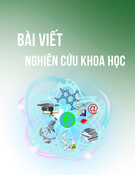
HPU2. Nat. Sci. Tech. Vol 04, issue 01 (2025), 39-47.
HPU2 Journal of Sciences:
Natural Sciences and Technology
Journal homepage: https://sj.hpu2.edu.vn
Article type: Research article
Received date: 19-12-2024 ; Revised date: 11-3-2025 ; Accepted date: 26-3-2025
This is licensed under the CC BY-NC 4.0
39
The ammonium adsorption capacity of coffee husk‑derived activated
carbon composite with MnFe
2
O
4
Thuy-Tien Do
a*
, Thi-Huyen Nguyen
a
, The-Duyen Nguyen
a
, Huu-Tap Van
b
a
Hanoi Pedagogical University 2, Vinh Phuc, Vietnam
b
Center for Advanced Technology Development, Thai Nguyen University, Thai Nguyen, Vietnam
Abstract
In this study, a composite material between MnFe
2
O
4
and activated carbon from coffee husks
(MFO/AC) was synthesized using co-precipitate and hydrothermal methods to remove ammonium from
aqueous solutions. The characteristics of MFO/AC were characterized and evaluated by scanning
electron microscopy (SEM) and Fourier transform infrared spectra (FTIR). The ammonium adsorption
process of MFO/AC was investigated through batch experiments, assessing parameters such as solution
pH (3 ÷ 8), contact time (5 ÷ 120 min), material dosage (0.2 ÷ 3 g.L
-1
), and initial ammonium
concentration (10 ÷ 60 mg.L
-1
). Results indicate that MFO/AC effectively adsorbs ammonium, which is
attributed to the functional groups on the composite surface. The maximum ammonium adsorption
capacity of MFO/AC was 15.97 mg.g
-1
at an initial ammonium concentration of 20 mg.L
-1
, pH 7,
material dosage of 1.5 g.L
-1
, and contact time of 80 min. The MFO/AC composite material has the
potential to be an effective agent for ammonium removal from wastewater.
Keywords: MnFe
2
O
4
/AC, ammonium, composite materials, coffee husk, activated carbon
1. Introduction
Ammonium (NH₄⁺) is an essential nutrient for plants and living organisms; however, at elevated
concentrations, it poses significant risks to human and animal health [1]. In recent decades, the rapid
development of industry, urbanization, and population growth has led to increasing pollution of natural
water sources. Agricultural activities, particularly the widespread use of fertilizers, coupled with
nitrogen-rich wastewater from agricultural and domestic sources, have contributed to the contamination
of groundwater with nitrogenous compounds, primarily ammonium. Although ammonium itself is not
acutely toxic to humans, its transformation products (nitrite (NO₂⁻) and nitrate (NO₃⁻)) are highly toxic
*
Corresponding author, E-mail: dothuytien@hpu2.edu.vn
https://doi.org/10.56764/hpu2.jos.2024.4.1.39-47

HPU2. Nat. Sci. Tech. 2025, 4(1), 39-47
https://sj.hpu2.edu.vn 40
[2], [3]. These compounds are formed through microbial oxidation processes during water treatment,
storage, and transportation. If untreated, ammonium can be converted into nitrate in the human digestive
system, potentially causing methemoglobinemia and other severe health issues, particularly in children
and pregnant women. This poses a substantial risk to both aquatic ecosystems and human health [4].
Current methods for ammonium removal include adsorption, stripping towers, chemical precipitation,
electrochemical treatments, and biological processes. However, stripping towers are energy-intensive,
and chemical precipitation can introduce secondary pollutants. Therefore, adsorption has emerged as a
preferred method for ammonium removal in recent years due to its simplicity, cost-effectiveness, and
ease of operation.
MnFe2O4 material with outstanding properties such as high saturation magnetization, good
durability, and high catalytic activity is an effective adsorbent to remove pollutants from aqueous
solutions [5]. Therefore, this material and its derivatives have been used as effective adsorbents for the
removal of heavy metal ions, dyes, pesticides, and other pollutants [5]–[9]. The MnFe₂O₄/C
nanocomposite shows excellent potential for environmental treatment due to its ability to combine the
adsorption properties of both activated carbon and MnFe₂O₄. This combination often leads to higher
adsorption efficiency and capacity than using each material alone [10]. However, the performance
depends strongly on the mass ratio of activated carbon to MnFe₂O₄ in the composite and other
influencing factors. Activated carbon typically contains oxygen-based functional groups, such as
carboxyl (-COOH), hydroxyl (-OH), and alcohol (-C-O), which play an important role in the adsorption
process [11]. In recent years, the application of composite materials based on MnFe₂O₄ and agricultural
by-products for ammonium removal from aqueous solution has been relatively underexplored in
scientific research. This study synthesized composite materials between MnFe2O4 and activated carbon
from coffee husks (MnFe2O4/AC) by the co-precipitate and hydrothermal method to remove ammonium
in aqueous solution. The ammonium adsorption capacity of MnFe2O4/AC was evaluated by examining
factors such as pH, adsorption time, adsorbent content, and initial ammonium concentration, allowing
for an estimation of the composite material's maximum ammonium adsorption capacity.
2. Experimental
2.1. Chemicals and experimental equipment
The main raw materials used in this study are MnCl2·4H2O and FeCl3·6H2O (Merck, Germany,
99%), HNO3 (63%), NaOH (96%), ethanol (China), KNaC₄H₄O₆·4H₂O (50%), NH₄Cl (Merck), Nessler
reagent (Merck), argon gas, deionized water, and coffee husk.
Experimental equipment includes a UV-VIS 730 spectrophotometer (Japan), an IKA horizontal
shaker, a CDC401-HACH handheld pH meter, an Ohaus drying oven (USA), a centrifuge, an oven and
an analytical balance.
2.2. Composite materials manufacturing
To prepare activated carbon (AC), coffee husks were repeatedly washed with distilled water to
remove impurities. The cleaned coffee husks were then dried in an oven at 110 °C for 24 hours and
crushed to a uniform particle size of 0.5–1 mm. The coffee husks were subsequently soaked in a HNO3
solution at 80 °C for 4 hours. The HNO3 concentration used was 3 M, with an impregnation ratio
(weight/volume) of coffee husk to HNO3 at 1:10 [12]. The solid material was washed multiple times
with distilled water until the pH stabilized at 7–8 and then dried at 70 °C to a constant weight. Next, 10

HPU2. Nat. Sci. Tech. 2025, 4(1), 39-47
https://sj.hpu2.edu.vn 41
g of the blended coffee husks were placed in a porcelain cup and heated at 350 °C for 60 minutes in a
furnace under an argon gas, with a controlled heating rate of 5 °C/min.
To synthesize MnFe2O₄ (MFO), a salt solution of MnCl₂·4H₂O (50 mL) and a salt solution
FeCl₃·6H₂O (50 mL) was prepared in distilled water with an Mn²⁺ to Fe³⁺ molar ratio of 0.1:0.2 M in a
conical flask (Flask 1). The mixture was stirred for 90 min using a magnetic stirrer. Simultaneously, 65
mL of NaOH solution (2 M) was prepared in another conical flask (Flask 2). Both flasks were then
heated in a water bath until the temperature of the solutions reached 80 °C. The solution from Flask 1
was carefully poured into Flask 2 while maintaining constant agitation, and the mixture was stirred at
80 °C for an additional 90 minutes [10]. We see a black precipitate appearing, which is the MnO.Fe2O3
(MnFe2O4) precipitate. The resulting mixture was filtered, and the precipitate was thoroughly washed
with distilled water until a neutral pH (pH = 7) was achieved. The final precipitate was dried at 80 °C
for 24 hours and labeled as MFO.
To synthesize the MFO/AC nanocomposite, MnFe2O₄ and coffee husk-derived activated carbon
were mixed in various ratios of 1:3% by weight. The mixtures were prepared in conical flasks using
both co-precipitation and hydrothermal methods simultaneously. Subsequently, 70 mL of double-
distilled water was added to each flask, and the contents were stirred for three hours using a magnetic
stirrer. The flasks were then transferred to a Teflon-lined stainless-steel autoclave and subjected to
hydrothermal treatment at 200 °C for 12 h. After the hydrothermal process, the samples were allowed
to cool to room temperature, centrifuged until reaching a neutral pH (pH = 7), and then dried at 80 °C
to a constant weight.
2.3. Adsorption experiments
The ammonium adsorption capacity of the MFO/AC nanocomposite was assessed under various
conditions, including pH (3÷8), contact time (5÷120 minutes), adsorbent dosage (0.2–3 g/L), and
ammonium solution concentrations (10÷60 mg.L-1). The initial ammonium concentration for the
experiments was set at 20 mg.L-1. Adsorption experiments were conducted in a beaker with continuous
stirring at 120 rpm using a horizontal shaker under room temperature conditions (25 ± 2 °C). After the
adsorption process, the samples were allowed to settle, and filtered, and the ammonium concentration
was determined at a wavelength of 450 nm using the standard calibration curve y = 0.1053x – 0.0004
with R2 = 0.9991. Each experiment was repeated three times, and the average values were calculated for
analysis and evaluation.
The adsorption capacity was calculated using equation (1), while the adsorption efficiency was
determined using equation (2):
qe = ( )
(1)
H = ( )
× 100% (2)
where: qe: adsorption capacity of the material (mg.g-1); Co: initial ammonium concentration (mg.L-1);
Ce: residual ammonium concentration in the test solution (mg.L-1); V: volume of solution (L); m: mass
of material (g).
Data analysis was conducted using Excel software, while graphs and adsorption modeling were
performed with Origin 2019 software. The data presented in the graphs are expressed as the mean ±
standard deviation.

HPU2. Nat. Sci. Tech. 2025, 4(1), 39-47
https://sj.hpu2.edu.vn
42
3. Results and discussion
3.1. The surface structure of the material
The SEM image in Figure 1 shows that activated carbon (AC) morphology was inert, had large
particle size, and had few pores (Figure 1a). In contrast, the surface of MFO/AC displayed small
reflective particles unevenly dispersed on a smooth and porous substrate (Figure 1b). This indicates that
the composite process facilitated the adhesion of MnFe
2
O₄ particles to the surface of activated carbon,
resulting in a composite material with enhanced porosity and a smoother surface.
Figure 1. The SEM images of AC (a) and MFO/AC (b).
The results in Figure 2 show the presence of –OH group stretching vibration at 3439 cm
−1
in
MnFe
2
O
4
and 3424 cm
−1
in MFO/AC. On the MnFe
2
O
4
surface, the peak at 432 cm
-1
and 634 cm
-1
corresponds to the vibration of the Fe-Mn–O bond in the material [13]. On the MFO/AC surface, a broad
ridge at 2926 cm
−1
is attributed to C–H stretching vibration under alkaline conditions. Additionally, the
presence of a C–O group was observed at 1384 cm⁻¹, while the peak at 1618 cm⁻¹ is associated with
C=C groups [14] in MFO/AC. Notably, the adsorption peak at 634 cm
−1
for MnFe
2
O
4
shifted slightly to
574 cm
−1
in MFO/AC, indicating the vibration of the Fe-Mn–O bond [13].
Figure 2. FTIR spectrum of MnFe
2
O
4
(a)
and
MnFe
2
O
4
/AC (b).
Figure 3. pH
PZC
of MnFe
2
O
4
/AC.

HPU2. Nat. Sci. Tech. 2025, 4(1), 39-47
https://sj.hpu2.edu.vn
43
The isoelectric point (pH
PZC
) is a critical parameter in understanding the adsorption of ions from a
solution onto the surface of solids. The pH
PZC
of the MFO/AC composite material, as determined from
the results shown in Figure 3, was found to be 5.5, indicating a weakly acidic surface. When the pH of
the solution is less than pH
PZC
, the surface of the composite material becomes positively charged,
enhancing the adsorption of anions. Conversely, when the pH exceeds pH
PZC
, the surface becomes
negatively charged, favoring the adsorption of cations [15]. This pHpzc value provides a fundamental
basis for understanding and explaining the adsorption mechanism of ammonium ions in water by the
MFO/AC composite material.
3.2. Factors influencing the ammonium adsorption capacity of MFO/AC
3.2.1. Effect of pH on ammonium adsorption capacity
Figure 4. Effect of pH on ammonium adsorption
capacity of MFO/AC (at contact time 20 minutes,
adsorbent dosage 0.6 g.L
-1
and C
o
= 20 mg.L
-1
).
Figure 5. Effect of time on ammonium adsorption
capacity (at pH = 7, adsorbent dosage 0.6 g. L
-1
and
C
o
= 20 mg.L
-1
).
The results in Figure 4 indicate that as the pH value of the solution increases from 3 to 7, the
ammonium adsorption capacity of MFO/AC gradually increases, reaching its highest value at pH 7, with
an adsorption capacity (q) of 3.83 mg·g⁻¹ and an ammonium removal efficiency of 11.48%. However,
as the pH increases further (from 7 to 8), the ammonium adsorption capacity of the material decreases
sharply. This can be explained as follows: at a pH range of 6–7, ammonium predominantly exists in the
form of NH
4+
[16], while the MFO/AC material surface is negatively charged due to its pH
PZC
value of
5.5 (Figure 3). Consequently, the negatively charged MFO/AC surface electrostatically attracts NH
4+
,
leading to a rapid increase in ammonium adsorption capacity, peaking at pH 7. When the pH exceeds 7,
the ammonium adsorption capacity decreases sharply due to the increasing concentration of OH
-
ions in
the solution. In addition, when pH > 7, part of NH
4+
is converted to NH
3
, which is less effectively
adsorbed. These findings confirm that the primary mechanism of ammonium adsorption on MFO/AC is
surface adsorption through electrostatic attraction between the negatively charged MFO/AC surface and
NH
4+
ions in the solution. This result aligns with the findings of A. Alshameri et al. [17] and X.G. Wang
et al. [18]. Based on these findings, the optimal pH for this study was determined to be 7.
3.2.2. Effect of time on ammonium adsorption capacity
The results in Figure 5 demonstrate that adsorption time significantly influenced the ammonium
adsorption capacity on the MFO/AC surface. During the initial 5–80 min, the ammonium adsorption


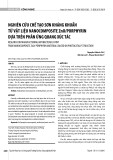
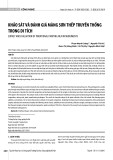
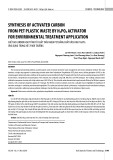
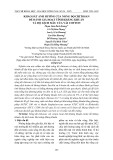

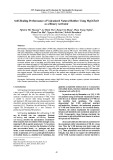
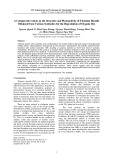

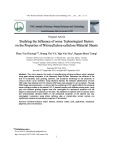

![Tài liệu Vi sinh vật môi trường [Mới nhất]](https://cdn.tailieu.vn/images/document/thumbnail/2025/20251123/ngkimxuyen/135x160/21891763953413.jpg)
![Sổ tay truyền thông Phân loại chất thải rắn sinh hoạt trên địa bàn tỉnh Quảng Nam [Chuẩn nhất]](https://cdn.tailieu.vn/images/document/thumbnail/2025/20251114/kimphuong1001/135x160/1701763094001.jpg)


![Quản lý chất thải nguy hại: Sổ tay Môi trường [Chuẩn nhất]](https://cdn.tailieu.vn/images/document/thumbnail/2025/20251029/kimphuong1001/135x160/9011761720170.jpg)





